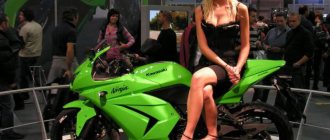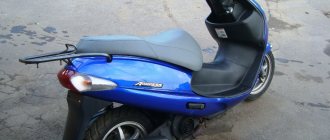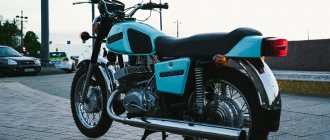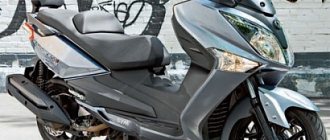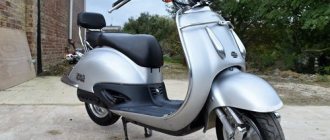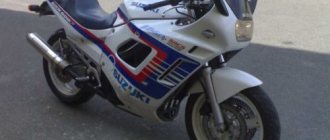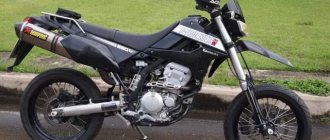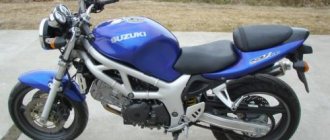Review of the Kawasaki EN 400 Vulcan motorcycle
The dynamics are crazy, the bike is responsive, so I had to learn to release the clutch correctly. The first days it shamefully stalled when trying to move away from a traffic light. But keep in mind that this was my first time on a motorcycle. (Rides in Uncle Vasya's Minsk at the dacha don't count) But the combination of a chopper chassis with a high-speed sports engine provides amazing opportunities - should you take a quiet ride while admiring the surrounding nature?
Please. We need to show the shabby little bastard that his place is near the bucket? Easily.
The gears are long, the engine pulls equally well both at low and high speeds, so there is no need to frantically catch the moment when it’s time to change gear. When it works out, then it will switch.
The rear shock absorbers are reliable - they were used under the previous owner, they lasted a season under me (6 thousand) and, as they said at Kamikaze (I recommend them there. Competent, nice guys), at least the season is still going away. I won’t say anything about the fork yet, since, as it turned out, I rode a dead one all season. =)
The seat is very comfortable, so much so that it is already relaxing. I’m thinking of installing a removable backrest for myself (not for the passenger - he already has one) but for myself. By the way, about the passenger. The bike is of course solo. That is, there is a back seat, the passenger sits down, the bike pulls, but (!) it starts to eat quite a bit of fuel. If with me alone, he takes about 5-6 per 100, then with a passenger at least a liter more. In general, as I understand it, the passenger seat is there solely to “take the girl from the bar to the bed.” And it is right ! Women come and go, but the bike lasts a long time.
In general, as soon as I got used to the clutch, I stopped getting off it.
Maybe for the night. The biggest disadvantage, in my opinion, is the lack of a glove compartment. Completely. A tiny little pencil case for some instrument under the seat, I think, is not worth mentioning. So it's time to buy panniers. Gears shift well, and there are no problems with neutral either. Well, it almost doesn't happen.
3 10 times one neutral is not caught immediately. I haven’t figured out the patterns yet.
The same Kamikazovites said that everything was fine with the box, so it’s not a bug, it’s a feature. A ! Main ! I almost forgot. He doesn't have a chain. And not the cardan. He has a BELT!
Moreover, the manufacturers swear that the belt is Kevlar, God knows what, and the warranty mileage of the belt is 800 thousand. I don’t know - I don’t know.. But during the season I was never at all interested in what my engine was transmitting to the rear wheel. That is, no maintenance is required for this node. At all.
It takes turns very easily, holds the turn confidently, that is, although I was afraid every time, there was not a single skid, loss of road or other nasty things.
I put it down, went through the turn, picked it up. (Pah-pah-pah)
The front brake grabs you to death (I almost tumbled over the steering wheel a couple of times), so after a while I learned to pretend to use my hand to imitate ABS =)
The rear brake applies softly and gradually, but if you press harder, it also holds firmly. On a good road, even if the wheel is blocked, it slides straight, but on crap (gravel, cobblestones, dead asphalt) it skids. For some reason it always goes to the right. For the first month I only used the rear brake.
So, the downsides are the lack of a glove compartment, and a tight, sensitive clutch (swing your left hand!)
And the rest are advantages.
A few impressions... The motorcycle is a beast, more of a dragster. I didn’t realize that a chopper could be so sporty, but now if you take a bike, then only a dragster. About the service. Consumables don’t bite, but you need to monitor the condition of the timing chain and tensioner, adjust the valves every 10-12 thousand km, due to the design, and to adjust, you need to drain the cooling system - a small unpleasant detail. The drive is a belt, it runs for a long time, it can easily withstand 50 thousand, but replacement will cost a tidy sum: about 30,000 rubles.
About my personal repair experience: a bike was stolen a couple of years ago and hit a tree. Tank, fork, tidy (rare, like on the LTD 454, with a tachometer), headlight mounts, turn signals (everything), steering wheel in half, the radiator began to sweat, something like this. The steering wheel, from disassembly for 1500 rubles, is straight - it’s actually become more convenient to toss and turn around the city. It hit the radiator because... The procedure “pour 100 grams in 2 weeks” did not bring any particular discomfort. I made the fasteners natively, using (almost) straight hands. The tank was straightened and painted by friends (0 rubles on the Master Card). Turn signals China “chopper type, chrome type” about 1500 per set. The tachometer had to be amputated (it was really inconvenient without it, it wasn’t enough for my eyes). Master Uncle Vova straightened the feathers, everything was perfectly straight (a bubble of 0.5 cognac). A year ago I came across a donor for 20,000, the same bike, ENTIRELY spray painted with black mat (collective farm Herods), dockless. I immediately went to pick it up 300 km away on a Gazelle (3000 to a friend). The bike turned out to be running, the engine was alive. I immediately amputated the fork, the tidy (working!), and the radiator. Now I don't bother at all. A problem happened on the original engine: a washer (no idea where it came from) got between the timing chain and the crankshaft sprocket, the result was removal and disassembly of the engine. Diagnosis - the tensioner and chain are ready. I found a solution right away; in one day I swapped the engines (fortunately, the engine is now a spare part). That's how it happens.
Hodovochka. The volcano is really low. Yes, yes, all the police must be passed carefully, at the speed of a drunken turtle, otherwise the connection of the mufflers from below begins to suffer. The suspension is very soft, but no penetrations were noticed. At speeds the motorcycle feels very confident; at a speed of 130 km/h the truck practically does not notice. The fork is pneumatic-hydraulic, this allows you to more accurately prepare the bike for a specific trip.
The gearbox is 6-speed, which is quite enough. The engine is slightly derated compared to the KLE series, but in sixth gear at a speed of 60 km/h it begins to accelerate quite confidently. You often come across cries for help from the owners, saying they have trouble starting in the cold. This is fine! I almost started to remove my head to check the valves, but I thought better of it in time. The motorcycle in winter (it was necessary, it was necessary) started on only one cylinder, and as it warmed up, sometimes the second one began to turn on. After warming up with a heat gun, the motor worked like clockwork. Overall, an excellent bike for the money, with a moderate appetite, reliable, very nimble. Moreover, with a pusher, the dynamics almost do not change, only the consumption increases slightly.
Go to the Kawasaki EN 400 Vulcan
Suzuki gsf 400 bandit: technical specifications
The technical characteristics, which are almost identical for all Suzuki bandit models, have justified themselves 100% in two years. With a volumetric gas tank of 16 liters, gasoline consumption is pleasing: from 5 to 6.5 liters per hundred. Long trips were not burdensome in terms of finances and frequency of refueling. The modest weight of “Daring” is 168 kg. Helps out both on the road and in the garage. The girl will also raise the fallen “bully”. I will provide basic data and characteristics below.
The dimensions of this device are ideal for stability on the road. They provide high dynamics and maneuverability in the city and hard-to-reach places:
The engine is in-line, 4-cylinder, 16-valve - quite suitable for the weight of the motorcycle. The power is 59 l/s, the volume is 398 cc/cm. Cooling: liquid radiator.
Most four hundred cars have a limiter of 180 km/h. On my Suzuki Bandit 400, I reached a maximum speed of up to 190 km/h. The steel frame of this bike deserves special attention. The tubular frame and the engine are one piece - it is not hidden behind plastic, it looks reliable and stylish. The pendulum mounting points are reinforced with additional castings.
Suzuki bandit 400: modifications by year
The Suzuki Bandit motorcycle was produced for a little less than ten years - from 1989 to 1997, without any special design changes. During the time I owned "Daring" (sold a year ago), I was actively interested in its history.
Suzuki GSF 400 Bandit - called grey-headed. This is the first standard version.
Suzuki GSF 400 Bandit V – red head version. With an integrated valve timing expansion mechanism. This system provides sharp acceleration from 8000 rpm. Not only the cylinder head was red, but also the front brake discs. This innovation provoked an increase in the popularity of "Bandit". Based on this model, the Suzuki RF 400, sport/tourer, was released.
According to the official catalog of manufacturers, each modification is assigned individual codes. You can find this information on a sticker under the saddle. It contains the following data: Suzuki GSF 400 **. The asterisks indicate the year code and model. Just below there is an inscription by which you can check the original color.
1989 – start of production and sales of Suzuki Bandit 400
The model is assigned code K. Characteristic features: gray color of the cylinders. The coloring of the first "Bandits": black with a blue streak and red.
1990 – Limited version released
1991 – production of stock models continues, and modification V appears
In the first half of the year, production of standard “grayheads” is underway. The year code for this model is M. Under the code is MV, in the second half the “red-headed” V version was released. This characteristic feature increased the demand for new bikes. “Standard” colors: red, black and red with a silver frame.
Version two, luxury. Limited V pleases with a double color: silver-blue and silver-red, and the main indicators have not changed.
The year 1991 was marked by the opening of supplies of “Hooligan” to Europe. For each country, different versions of the Suzuki bandit 400 were produced. It is reliably known that there were cosmetic solutions for the color of the exhaust system, fork and brake discs. Models for Germany were equipped with a 50 hp engine and round mirrors were installed on them. For England, the power unit remained the same, but the front brake was single disc.
1993 – power reduction and speed limit by manufacturer
Changing Japanese laws led to the “strangulation” of 400 cc equipment to 53 hp. and a speed limit of up to 180 km/h. As a consolation, a small trunk was added under the seat. Since the spring of 1994, all modifications have been produced with an electronic limiter.
1995 – appearance of the second generation
The appearance of the “red head” restyling in 1995 under the code S marked the second life of the 400. The updated design, lightweight chassis, aluminum swingarm and shortened wheelbase bring a modern spirit to this version. Characteristic features: dual seat, red and yellow front hub and silver fork. Of course, the red head on the cylinder block remained unchanged.
1997 – end of production
The next tuning of the “red-headed” Suzuki bandit 400 left the technical characteristics in the previous version. The only thing that marked it significantly was the appearance of modern aggressive fairings. Variations of the muffler and color scheme appeared. The code of the last "Bandit" of 1997 is V.
Over the years, Japanese designers have changed the shape of attachments and perfected the engine and chassis. We experimented with materials from chromium to aluminum. We don’t know what prevented manufacturers from using such promising potential for further restyling in full. But, despite the fact that restrictions “strangled” at least 15% of the possibilities, the daring character of the motorcycle has been preserved and continues to delight owners.
Suzuki bandit 400: pros and cons
During the two-year period of managing “Daring”, I formed my own view of its advantages and disadvantages. I liked the aggressiveness of “Bandit” - this fully corresponds to its name. Over time, I got used to both the restless throttle and the sharp acceleration. The bike's groovy nature doesn't interfere with the efficient and predictable operation of both disc brakes.
The rear shock absorber is carefully covered from dirt by a fender liner. If necessary, you can adjust the rear suspension to suit your weight, needs and roads. This is done using a system that controls the compression of the springs. And, of course, the engine. It owes its angry streak to the sporting roots of the Suzuki GSX-R400. Its reflection is two fairly short initial gears, and a powerful pickup that begins in standard models around 10,000 rpm.
Suzuki bandit will not do without complaints. The front suspension is too soft for our conditions and requires immediate intervention. You won't be able to drive on average quality tires - this technique only requires good tires. But the saddest thing for people taller than 170 cm is the low frame. Discomfort is caused by the driver's seating position and the position of the legs. All tuning attempts are in vain. All that remains is to adapt to this geometry of the driver’s seat.
The timing chain tensioner often gets stuck - this needs to be checked regularly. Spark plug wells have a large diameter, which is why dust and debris collect there. Before screwing in the spark plugs, it is better to blow out the wells.
